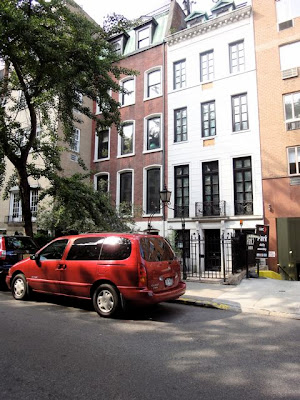For
a number of years I photographed a wisteria on 71st Street between
Park and Lexington Avenues in Manhattan.
It was growing up the face of a townhouse, having been planted years ago
in a small courtyard leading to the front door.
The
house is unmistakable. It is gracious,
three windows wide, one of which was completely obscured by wisteria from the
ground floor to the roof. The wisteria
grew not only upward but outward as well, leaping to the adjacent house. I caught up with the owner of the adjacent
house one afternoon. “Surely,” I said, “you
resent the encroaching out-of-control wisteria.” “Oh no,” he replied, “we rather like
it.”
 |
| Wisteria on the March |
Meanwhile,
the courtyard paving of the principal house
had
heaved as the wisteria continued its relentless march up the front facade. The doctor occupying the ground floor office,
while stepping cautiously over the heaving pavement, said, “I don’t really mind
it. I’m only annoyed when I forget the
trunk I’ve lashed over the front door and bang my head.” Clearly, New Yorkers regard any sign of
vegetation as a bonus, no matter how intrusive.
 |
| Principal House Courtyard |
Am
I alone in the War against Wisteria? In
the Catskills we finally succeeded in removing the wisteria that was choking
the base of a stone tower and wrapping itself around the outside
staircase. These shoots were the
children of a wisteria 60 feet away; they had made their way underneath 20 feet
of stone terrace, and then shot across 40 feet of lawn to make it to the base
of the tower.
We
took the parent plant down to the ground last summer, and it is sending out
shoots again. It had been left
unattended for years, if not decades, and had overtaken a massive stone
fireplace and the aforementioned stone terrace, pushing up large flagstones
with its roots before heading out across the lawn to the tower. Of course, there was damage to both the
exterior and interior of the house. I
don’t think I’ve mentioned that all this wisteria grew from a cramped
one-by-two foot pocket at the base of the fireplace.
Within
two weeks the wisteria had sprouted anew, indifferent to our best efforts. By early this spring it had started up the
wall again, wrapping itself through a door handle on the way.
 |
| West Side Brownstone Window |
Whenever
you start to prune an old wisteria, take a deep breath and ponder the future
carefully before you begin. Timing is
important here. Wisteria buds appear in
late summer or early spring, and the spectacular flower panicles bloom in early
spring the following year. When not
pruned regularly, buds will refuse to set, resulting in the solid green wall on
East 71st Street, and the similar blockage on the west side of
town.
Your
wisteria won’t destroy you if you pay attention to its pruning requirements. It will need regular pruning to keep its
growth in check and to encourage flowers.
Often, wisteria grown on a wall doesn’t bloom because it is impossible
to prune it without erecting scaffolding.
 |
| East 71st Street in Winter, Unpruned |
This
is the time to make sure your ladder is equal to the task, and not a spindly
kitchen stepladder. If your wisteria has
any age to it, the branches will be thick and difficult to cut. You will also have long, waving stems to
contend with, and masses of foliage getting in your way. As you struggle deep within the vines, make
sure help is within shouting distance.
For
pruning wisteria, you should need only three tools: a good pair of hand
clippers kept clean and sharp; a pair of
loppers -– long-handled pruners essential for cutting heavy branches; and a
good folding hand-saw or an axe to take care of the largest branches.
If
your wisteria is blooming well, prune it twice during the growing season; once
in the first week in July, and again in early September. If it has gotten out of hand, start earlier.
In late winter, cut back all shoots to within two or three buds of the point
where they started to grow during the previous season. Then prune again in mid-summer by cutting the
current season’s new shoots to within five to six buds of their bases.
 |
| Well-controlled Wisteria Over Carport, Cambridge, MA |
If
you are not meticulous about annual pruning, perhaps the lesson in this is not
to plant wisteria against any building you care about. Even a well-constructed arch or arbor will
not withstand the onslaught of a vigorous wisteria. Don’t even think about a trellis.
 |
| Wisteria in the Garden |
If
you must have wisteria, build a stout pergola as far away from the house as
possible. Select the largest cedar posts
you can find and the strongest planed beams you can imagine. Set the posts firmly in concrete and make
sure your cross beams are attached for life.
Once you have designed a pergola strong enough to support the weight of
the wisteria, make sure it is long enough to carry visually the weightiness of
the plant itself. Plan your pergola so that you can walk beneath it
to another part of the garden. Or set it
facing a view, with a bench underneath.
If cared for well, your wisteria will provide unparalleled bloom in
spring. Just be prepared to add another
dependent to your family.
 |
| East 71st Street Houses, Finally Cleared |
As
to the fate of the houses on East 71st Street, new owners seem to
occupy both. Damages to the facades have
been repaired. The wisteria has been pulled off the walls and hacked back to
nothing. However, if you look very
closely at ground level…